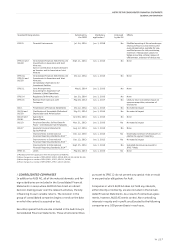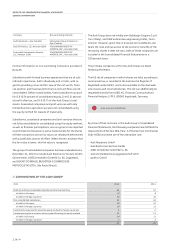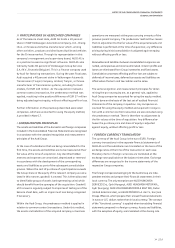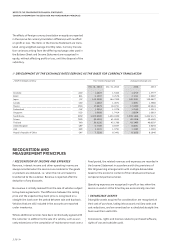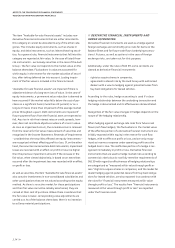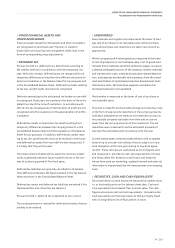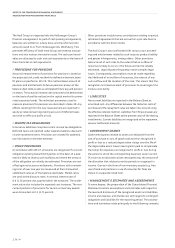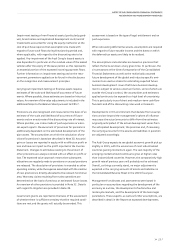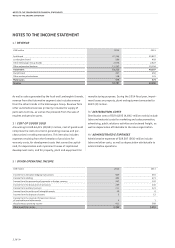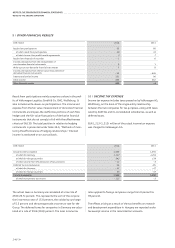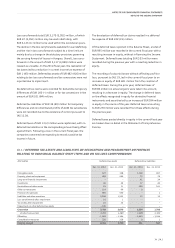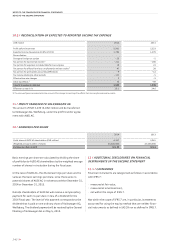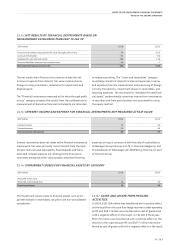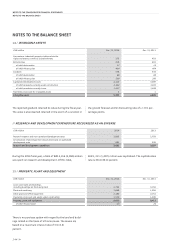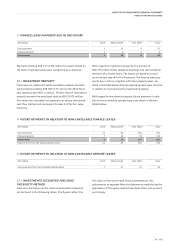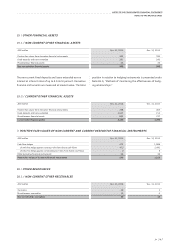Audi 2014 Annual Report Download - page 237
Download and view the complete annual report
Please find page 237 of the 2014 Audi annual report below. You can navigate through the pages in the report by either clicking on the pages listed below, or by using the keyword search tool below to find specific information within the annual report.
NOTES TO THE CONSOLIDATED FINANCIAL STATEMENTS
RECOGNITION AND MEASUREMENT PRINCIPLES
>>
237
Impairment testing of non-financial assets (particularly good-
will, brand names and capitalized development costs) and of
investments accounted for using the equity method or at the
cost of purchase requires that assumptions be made with
regard to future cash flows during the planning period and,
where applicable, with regard to the discounting rate to be
applied. Any impairment of the Audi Group’s leased assets is
also dependent in particular on the residual value of the leased
vehicles after the expiry of the lease period, as this represents
an essential portion of the expected incoming payment flows.
Further information on impairment testing and on the mea-
surement parameters applied can be found in the disclosures
on the recognition and measurement principles.
Carrying out impairment testing on financial assets requires
estimates of the scale and likelihood of occurrence of future
events. Where possible, these estimates are based on historical
values. An overview of the value adjustments is included in the
additional Notes to the Balance Sheet pursuant to IFRS 7.
Provisions are also recognized and measured on the basis of an
estimate of the scale and likelihood of occurrence of future
events and on an estimate of the discounting rate of interest.
Where possible, use is also made of past experience or exter-
nal expert reports. Measurement of provisions for pensions is
additionally dependent on the estimated development of the
plan assets. The assumptions on which the calculation of pro-
visions for pensions is based are described in Note 30. Actuarial
gains or losses are reported in equity with no effect on profit or
loss and have no impact on the profit reported in the Income
Statement. Changes to estimates relating to the amount of
other provisions are always recorded with an effect on profit or
loss. The expected value approach means that subsequent
allocations are regularly made to provisions or unused provisions
are released. The dissolution of provisions is recorded as other
operating income, while the expense associated with the creation
of new provisions is directly allocated to the relevant functional
area. Warranty claims resulting from sales operations are
determined on the basis of previous or estimated future losses.
An overview of other provisions is provided in Note 32. Details
with regard to litigation are provided in Note 39.
Government grants are reported on the basis of the assessment
of whether there is sufficient certainty that the required condi-
tions are met and the grants will actually be awarded. This
assessment is based on the type of legal entitlement and on
past experience.
When calculating deferred tax assets, assumptions are required
with regard to future taxable income and the dates on which
the deferred tax assets are likely to be realized.
The assumptions and estimates are based on premises that
reflect the facts as known at any given time. In particular, the
circumstances at the time of preparation of the Consolidated
Financial Statements as well as the realistically assumed
future development of the global and industry-specific envi-
ronment are used as a basis for estimating expected future
business development. Given that future business develop-
ment is subject to various uncertain factors, some of which are
outside the Group’s control, the assumptions and estimates
applied continue to be exposed to a high level of uncertainty.
This is particularly true of short and medium-term cash flow
forecasts and of the discounting rates used in forecasts.
Developments in this environment that deviate from assump-
tions and are beyond the management’s sphere of influence
may cause the actual amounts to differ from the estimates
originally anticipated. If the actual development varies from
the anticipated development, the premises and, if necessary,
the carrying amounts for the assets and liabilities in question
are adjusted accordingly.
The Audi Group expects to see global economic growth pick up
slightly in 2015, with the economies of most industrialized
countries gaining momentum again. The vast majority of the
emerging markets should continue to grow at higher rates
than industrialized countries. However, the comparatively high
growth rate of previous years will probably not be achieved.
Overall, as things currently stand, no major adjustment is
expected in the carrying amounts of assets and liabilities in
the Consolidated Balance Sheet in the 2015 fiscal year.
Management’s estimates and assessments were based in
particular on assumptions regarding the development of the
economy as a whole, the development of automotive and
motorcycle markets, and the development of the basic legal
parameters. These aspects, as well as further assumptions, are
described in detail in the Report on expected developments.


